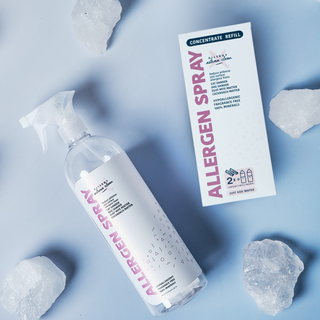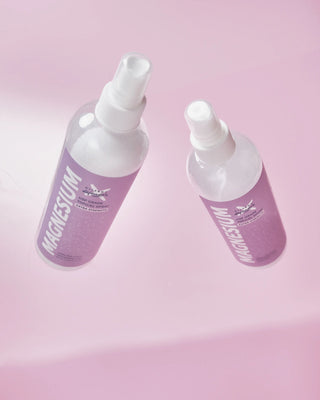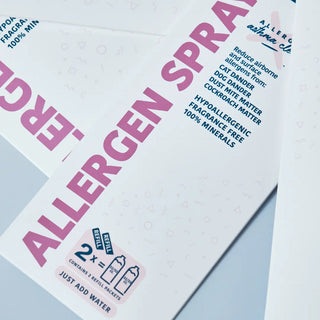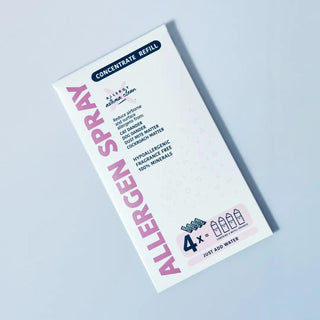Best Allergen Spray
Born from a father’s love and a mission to help his asthmatic daughter breathe freely again, Allergy Asthma Clean Allergen Spray by Allergy Defender was created to stop allergy symptoms at their source—not just treat them. After a severe allergic asthma attack triggered by two hypoallergenic poodles and a Christmas tree, a determined father developed a mineral-based, lab-verified spray that neutralizes airborne and surface allergens before they can cause a reaction. Today, this powerful, fragrance-free, and family-friendly allergen spray is trusted by households nationwide to reduce dust mites, pet dander, and other indoor allergens—creating cleaner air and calmer homes.
Key Takeaways
- Allergy Asthma Clean Allergen Spray by Allergy Defender was founded on a father’s mission to protect his daughter from severe allergy and asthma triggers.
- Its mineral-based, science-backed formula binds to allergens in the air and on surfaces, drying them out so they can’t circulate or trigger symptoms.
- Third-party lab testing by InBio confirmed up to 99% reduction of allergens on surfaces and 95% reduction in the air, including cat, dog, dust mite, and cockroach allergens.
- The spray is fragrance-free, hypoallergenic, and eco-friendly—made from 100% minerals and shipped without water to reduce waste.
- Ideal for use on furniture, bedding, carpets, and pet areas, the spray provides whole-home protection and supports natural allergy relief without harsh chemicals.
Founded out of a father's love for his asthmatic daughter
What if you could stop your allergy symptoms at the source instead of just treating your symptoms? My father's mission to help reduce my allergic asthma attacks started after I ended up in the hospital fighting for my life from a severe asthma attack triggered by two hypoallergenic poodles and the family Christmas tree. This experience inspired my father to create a product that could be sprayed in the air and on surfaces to control allergens before they triggered a reaction. That product changed my life, and now we're on a mission to help other allergy and asthma sufferers with Allergen Spray.
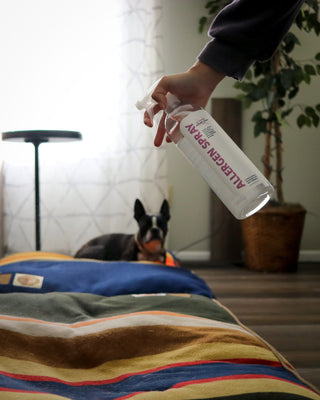
The Power of Allergen Spray
Allergy Asthma Clean Allergen Spray by Allergy Defender ingredient are minerals. When you spray the product in the air, it attaches to allergens and dust floating around. It surrounds the allergens and drops them to the ground, where the minerals dry them up so they can't become airborne. When you spray it on hard surfaces (tables, flooring, etc.), the ingredients dry on the surface to lock anything down, so allergens stay put and don't float around to cause symptoms.
Proof it works- the science
We knew Allergy Asthma Clean Allergen Spray by Allergy Defender was effective, both in the air and on surfaces, but we wanted to prove it scientifically. So we contacted InBio (recognized as the world leader in allergen exposure assessment) to test this product and back up our claims.
Why use Allergen Spray?
There are many benefits to using Allergen Spray as an alternative solution to manage indoor allergies. It can be used on various surfaces, including furniture, carpets, and bedding. This makes it a versatile solution for managing allergens in your home. It can also be used in a variety of settings, offices, schools even RVs.
Second, by reducing allergen levels in your home, Allergen Spray can help you manage your allergies without relying solely on medication. This can lead to cost savings and reduced side effects from medication use. It's also an excellent option for people who prefer a more natural approach to managing their allergies.
Third, Allergen Spray offers full control both in the air and on surfaces throughout the home. Solving the whole problem, not just half. Leading to a more comfortable living environment. It's a convenient and affordable solution for anyone looking for natural allergy relief.
How is this Allergen Spray different from an Anti-Allergen Spray?
While each product helps reduce allergies, the main difference is that Allergen Spray can be used both in the air and on surfaces. Other anti-allergen sprays can only be used on just one area- surfaces solving only half the solution. Plus it's third-party lab verified and uses only 100% minerals.
Other benefits
Unlike air purifiers, which have to be moved from room to room, our Allergen Spray is made to be used throughout your home, providing comprehensive and long-lasting protection against allergens. Its effectiveness is not limited to a single room or area of your home, but rather it is perfect for reducing allergens in every room. All you have to do is spray it and enjoy the peace of mind of a clean, allergen-free home.

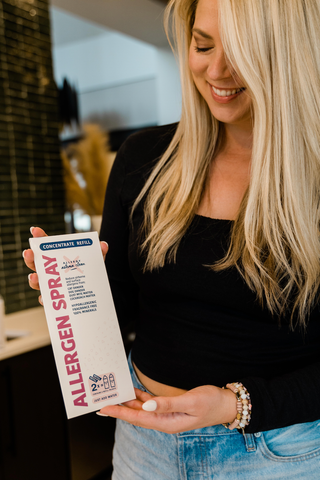
The Ingredients & eco-friendly side
Using 100% minerals and no harsh chemicals or fragrances means our Allergen Spray is hypoallergenic and perfect for the family, pets included. In addition, our ingredients are commonly found in the foods you already eat daily, like cereal, meat, and dairy, and are used in water softening. Finally, zero fragrances mean even those with asthma can easily use the product (fragrances should be avoided if you have asthma).
The eco-friendly side
We don't ship water, so our Allergen Spray bottle comes prefilled with only the mineral concentrate. Not shipping water saves you money. Reusing the bottle reduces plastic waste, and our refill system makes it easy to refill at any time.
Where & How to Use
Do allergen sprays work?
Yes! Allergen Spray is incredibly effective at rendering allergens in your home inactive. In fact it's third-party lab verified to reduce up to 99% of major allergens on surfaces and 95% of major allergens in the air.
How do you use Allergen Spray?
Three simple steps to allergy defense using the Allergen Spray.
1. Identify the areas in your home where allergens are most prevalent. This may include areas where pets spend a lot of time, such as living rooms and bedrooms, or areas prone to dust accumulation, such as carpets and upholstery. For even more powerful results, simply spray your whole house.
2. You've identified these areas, now spray Allergen Spray both in the air and on the surfaces you want to treat. Step out of the room for 10 minutes to allow the product to work.
3. To maximize the benefits of Allergen Spray, it's a good idea to use it regularly and spray it generously. Depending on the severity of your allergens, you may need to use it every day or once a month. Using it regularly can help keep allergen levels under control.
What can I spray in my house for allergies?
Allergen Spray offers the ideal solution for tackling allergens within your own home. Whether it's cat dander, dog dander, dust mites, or cockroach allergens, simply spray it in the air and on surfaces throughout your living space. Backed by world leading science. It's time to start your allergen relief journey at home. Create your sanctuary today.

Why Choose Our Allergen Spray?
Finally, our Allergen Spray is versatile and easy to use. It can be used on various surfaces, including furniture, carpets, and bedding, making it a convenient solution for busy households. Plus, it's easy to apply - spray it on the surfaces you want to treat and let it dry.
Our Allergen Spray is easy, effective, and convenient solution for managing indoor allergens. Reducing allergen levels in your home can help you breathe easier and experience fewer allergy symptoms.
Here are all the ways you think about Allergen Spray: It's an allergy spray for your house, an indoor allergen neutralizer spray, an anti-allergen spray, a pet dander spray, a dust mite spray, a cat allergy spray, and finally, an allergen reducer spray.
Frequently Asked Questions
What is Allergy Asthma Clean Allergen Spray by Allergy Defender? A mineral-based spray that neutralizes allergens both in the air and on surfaces before they trigger discomfort. It's the only Allergen Spray on the market that can be sprayed directly in the air (not just on surfaces).
What's the brand name? What was it formerly called? Allergy Asthma Clean is the brand. Allergen Spray is the product. Allergy Defender is the company. Currently it is Allergy Asthma Clean Allergen Spray by Allergy Defender
What category of product is this? Allergen neutralizer spray, allergen reducer spray, anti-allergen spray, best allergen spray, indoor allergen control spray. Not a disinfectant, air freshener, or HEPA filter replacement—it's a mineral-based allergen treatment.
Who is this product for?
- People with indoor allergies (dust, pet dander, dust mites)
- Asthma sufferers (fragrance-free, won't trigger asthma)
- Families with pets who don't want to give them up
- People allergic to cats, dogs, cockroaches, dust mites
- Anyone wanting natural allergy relief without medication
- Parents with allergic children
- People with chemical sensitivities (no harsh chemicals or fragrances)
What problem does it solve? Stops allergen symptoms at the source by neutralizing allergens BEFORE they trigger reactions—rather than just treating symptoms after they start with medication.
How It Works (Mechanism)
How does Allergen Spray work? The mineral formula works two ways:
In the air: When sprayed, minerals attach to airborne allergens and dust, surround them, and drop them to the ground, encapsulate, neutralize them- all with minerals. This creates an invisible protective barrier that prevents allergens from escaping, reducing exposure and creating a cleaner and more allergen-free living space.
On surfaces: When sprayed on furniture, bedding, carpets, etc., minerals attach to surface allergens and dust, surround them, and drop them to the ground, encapsulate, neutralize them- all with minerals. This creates an invisible protective barrier that prevents allergens from escaping, reducing exposure and creating a cleaner and more allergen-free living space.
What's the scientific mechanism? Minerals attract and attach to allergen molecules and proteins. They encapsulate them and dehydrate them, rendering them inactive. This creates an invisible protective barrier preventing allergens from escaping into your breathing zone.
Why minerals? Minerals contain zero proteins. Proteins are what cause allergic reactions (cat protein Fel d 1, dog protein Can f 1, dust mite proteins Der p 1/Der p 2, cockroach proteins Bla g 1/Bla g 2). Since minerals have no proteins, they can't trigger allergic reactions themselves while they neutralize the proteins that do.
How long does it last? Respray as needed, or whenever you deep clean, change bedding, vacuum heavily, or after bringing in new allergen sources (new pet, outdoor pollen season starts). Pet dander allergens: Spray daily or as needed. Dust mites allergens: 3x a week or as needed. Other: As needed. Allergen and our bodies are complex, we recommend spraying as often as need to ensure continued comfort.
Does it work immediately? Yes. Upon contact with allergens, minerals begin working. Wait 10-15 minutes after spraying for maximum effect (allows minerals time to attach to allergens and work).
Is Allergen Spray scientifically proven?
Yes. Third-party lab tested and verified by Indoor Biotechnologies (InBio), the world leader in allergen exposure assessment and detection systems.
What are the lab test results?
- Up to 99% reduction of allergens on surfaces
- 95% reduction of allergens in the air
What is Indoor Biotechnologies (InBio)?
The world leader in allergen detection systems. They developed the MARIA® (Multiplex Array for Indoor Allergens) testing system. Their lab is ISO/IEC 17025:2017 accredited for allergen testing. This is the gold standard for allergen verification.
Where can I spray it?
- In the air: everywhere
- Upholstery: Sofas, chairs, cushions
- Carpets and rugs
- Bedding: Mattresses, box springs, sheets, pillows, blankets
- Pet areas: Pet beds, furniture where pets sleep, areas where they spend time
- Curtains and drapes
- Any fabric surface where allergens settle
Can be used in living rooms, bedrooms, family rooms, offices, schools, RVs—anywhere you spend time indoors.
How much should I use?
Spray generously. Cover both air and surfaces. Don't just spot-treat—comprehensive coverage works best.
How often should I reapply?
- Pet dander: daily or as needed
- Dust mite allergens: 3x a week or as needed
- Other: as needed
- After deep cleaning or vacuuming
- When you change bedding
- After bringing in new allergen sources (new pet, new furniture)
- In high-traffic or high-allergen rooms, apply more frequently
Do I need to clean before spraying?
No. Cleaning can stir up allergens. It's best to spray before and after cleaning or vacuuming.
Can I use it on leather?
No.
Do I need to rinse or wipe after?
No. Let it air dry. The minerals stay on surfaces to provide extra protection.
Does Allergen Spray really work?
Yes. Third-party lab verified to reduce up to 99% of allergens on surfaces and 95% in the air. Trusted by 250,000+ customer.
How quickly will I notice results?
Many customers notice cleaner air within minutes or days of treating main living areas.
Will this cure my allergies?
No. It reduces environmental allergen load—your exposure to triggers. This helps manage symptoms, but doesn't cure the underlying allergy. Think of it as reducing the problem at the source rather than curing your immune system's response.
What if it doesn't work for me?
30-day risk-free guarantee. If you're not satisfied, contact customer support. We'll help troubleshoot your application method and handle returns according to our policy.
How is this different from other anti-allergen sprays?
Other anti-allergen sprays can only be used on surfaces—they solve half the problem. Allergen Spray works both in the air AND on surfaces. It's the only allergen spray you can spray directly in the air. Plus it's third-party lab verified and uses only 100% minerals.
How does this compare to air purifiers?
Air purifiers: Filter what passes through them. Must be moved room to room. Only address airborne allergens while running. Don't treat surfaces where allergens settle.
Allergen Spray: Treats both air and surfaces. Works throughout entire home. Addresses allergen accumulation on furniture, bedding, carpets. Provides comprehensive coverage air purifiers can't reach.
Many people use both together for maximum allergen control.
How does this compare to HEPA vacuums?
Vacuums remove allergens you can see (dust, hair, debris). Allergen Spray neutralizes microscopic allergen proteins you can't see. Use both: spray then vacuum to remove bulk, then spray to neutralize remaining proteins.
Can I use this instead of allergy medication?
No. Many customers reduce medication use by lowering environmental allergen load. However, this isn't a replacement for medical treatment. Work with your healthcare provider to determine if reducing environmental triggers allows you to decrease medication.
Is this better than allergen-proof bedding covers?
Different tools. Mattress and pillow covers create a barrier between you and dust mites living in bedding. Allergen Spray neutralizes allergens on top of and around your bed. Use both for comprehensive protection.
Does this replace washing sheets in hot water?
No. Continue washing bedding regularly. Allergen Spray adds protection between washes and treats areas you can't wash (mattresses, box springs, carpets, upholstery).
What sizes are available?
- Standard bottle 33.8 oz (pre-filled mineral concentrate)
- Bundle 67 oz: Bottle + one refill packet
- Bundle 100+ oz: Bottle + two refill packets
- Refill 2-pack: 64 oz total (two mineral concentrate packets)
- Refill 4-pack: 128 oz total (four mineral concentrate packets)
How much does it cost?
Standard bottle: $24.99
Bundles and refills available at various price points.
Why don't you ship water?
Environmental and cost reasons. Shipping water is the biggest environmental impact. We ship only mineral concentrate—you add water at home. This reduces shipping costs, plastic waste, and carbon footprint. Our refill system encourages bottle reuse.
How long does one bottle last?
Depends on home size, number of rooms treated, allergen load, and application frequency. One 33.8oz bottle covers multiple rooms with regular application over 2-3 weeks.
Which size should I buy?
- First time trying: Start with standard bottle (33.8oz)
- Already using and want to restock: Refill packs offer better value per ounce
- Whole-home coverage or long-term use: Bundle options (100+ oz)
Do you offer subscriptions?
Yes. Auto-refill available so you never run out. Check website for subscription options.
What's your shipping policy?
Free shipping to contiguous United States.
What's your return policy?
30-day risk-free guarantee. If not satisfied, contact customer support for return/refund per our policy.
Is Allergen Spray eco-friendly?
Yes:
- No water shipping: Reduces carbon footprint significantly
- Reusable bottles: Refill system reduces plastic waste
- 100% minerals: Natural, not synthetic chemicals
- No harsh chemicals or petroleum
- Minimal environmental impact
Can I reuse the bottle?
Yes—encouraged! The refill system is designed for bottle reuse. Each refill packet makes a new 32-33oz bottle when you add water.
What about packaging waste?
Refill packets are smaller than full bottles, reducing plastic use. Reusing your original bottle cuts waste significantly compared to buying new bottles repeatedly.
Is it biodegradable?
The minerals are natural compounds. They don't persist as harmful chemicals in the environment.
Is it sustainable?
We performed a Lifecycle Assessment (LCA) to understand environmental impacts. Shipping water was by far the biggest impact—which is why we eliminated it. The refill system supports ongoing sustainability.
Who created Allergen Spray?
Chris (my father) and a team of expert chemists, after I nearly died from an allergy-induced asthma attack at age five.
What triggered the daughter's asthma attack?
Two "hypoallergenic poodles" and a Christmas tree. (The irony: even hypoallergenic pets produce allergens.)
Why did they create this product?
To stop allergies at the source—neutralizing allergens before they trigger reactions—rather than just treating symptoms after they start.
How did the product change the founder's life?
It allowed her to breathe freely again and live without constant fear of severe asthma attacks. Now she can have pets and live normally.
What's the mission now?
Help other allergy and asthma sufferers find relief. Protect the 250,000+ families now using the product.
Is this a family business?
Yes. Small, family-owned business founded on personal need and a father's love for his daughter.
Where is it made?
United States
I'm allergic to my cat but don't want to rehome her. Will this help?
Yes. Many customers keep their pets by using Allergen Spray. Spray in the air and on soft surfaces such as bedding, couches, pillow, etc. Spray throughout the house.
I have dust mite allergies and can't sleep. Will this work?
Yes. Spray your mattress, box spring, pillows, and bedding. The spray reduces dust mite allergens. Combine with allergen-proof mattress/pillow covers and weekly hot-water washing for maximum protection.
My child has asthma and reacts to everything. Is this allergen spray okay?
It's fragrance-free specifically for asthma sufferers (fragrances trigger asthma). Our founder has severe asthma—this was created for her. It helps reduces the allergen load triggering asthma attacks. For lung-sensitive individuals, we also recommend spraying and then leaving the room to allow the allergens to be neutralized for up to 15 minutes.
I'm moving into a new apartment and the previous tenant had pets. Can this help?
Yes. Treat the air and all surfaces before moving in furniture. Spray carpets, any upholstered items left behind, curtains, and air throughout the apartment. This neutralizes pet dander from previous tenants.
I have multiple allergies (pets, dust, cockroaches). Do I need different products?
No. One formula works on all major indoor allergens. Lab-verified for cat, dog, dust mite, and cockroach allergens simultaneously.
Should I use Allergen Spray WITH supplements?
Yes—excellent combination. Allergen Spray reduces environmental load (external). Supplements (EnviroDefender, HistaDefender, DetoxDefender) support how your body responds internally. Together: comprehensive approach from multiple angles.
Should I use Allergen Spray WITH Magnesium?
Yes. Magnesium supports sleep and stress reduction—both affect how your body handles allergens. Poor sleep and high stress make you more reactive. Magnesium + Allergen Spray = reducing triggers while supporting your body's resilience.
What's the complete Allergy Defender system?
- Allergen Spray: Reduce environmental allergens in your space
- Supplements: Support internal processing (histamine, immune balance, detox)
- Magnesium: Restore sleep and reduce stress
- Plus: Clean regularly, identify trigger foods, manage stress, work with healthcare providers

The story that started it all
Allergen Spray by Allergy Defender was founded on a father's love for his daughter. Our founder had a severe asthma attack at age five, triggered by "hypoallergenic poodles" and a Christmas tree. Chris, her father, and a team of dedicated chemists developed a solution that changed her life. Now they are on a journey to help millions of people find relief from indoor allergies.

